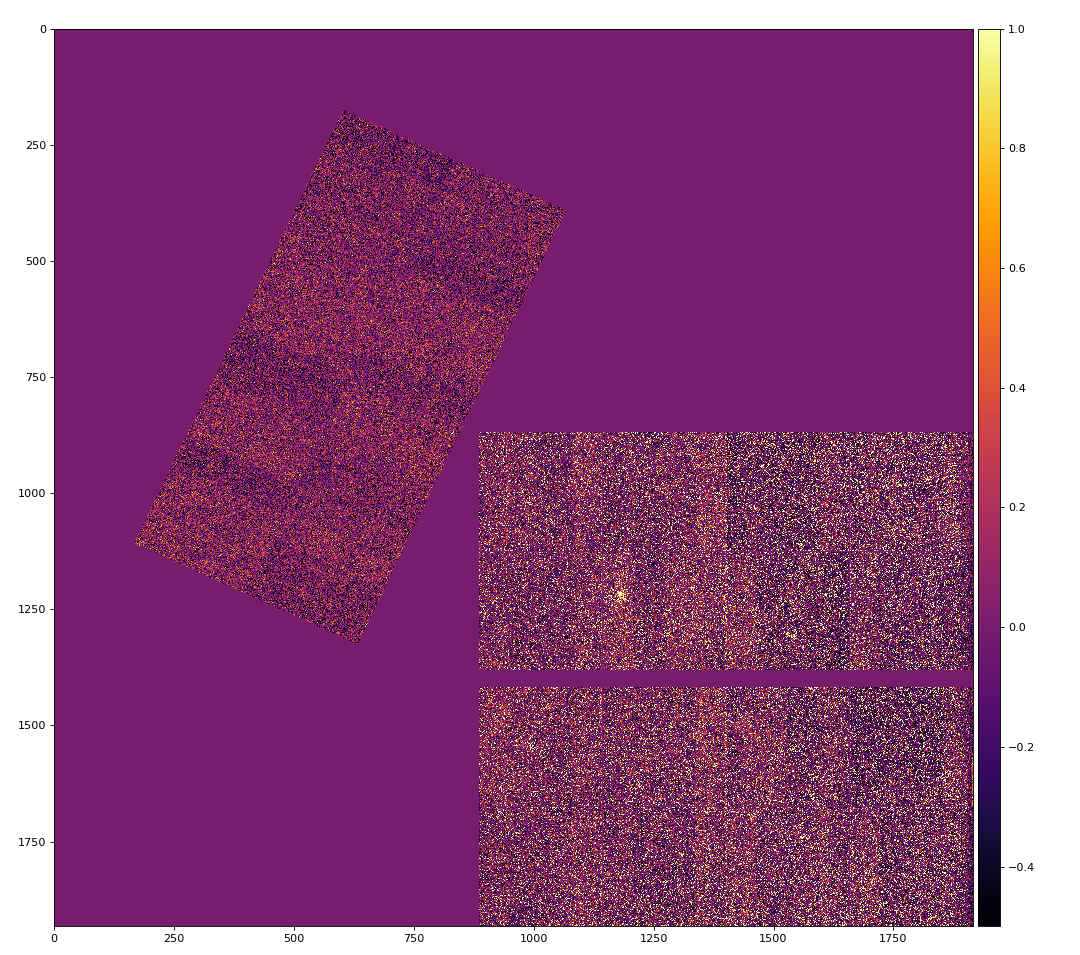Content
Problem
In Run 18 planned on Aug 2019 the new single-piece 4M Jungfrau detector is going to be used with a couple of controllers. In daq and psana it will be seen as two independent detectors, i.e. MfxEndstation.0:Jungfrau.0 and 1. It seems natural to process data of these two detectors as a single piece. To make it feasible class AreaDetectorCompound was developed with functionality as explained in this note.
Details of implementation
Class AreaDetectorCompound constructor receives as input parameter a list of detector names which need to be processed together. From this list it generates a list of AreaDetector objects, which is used to wrap most of AreaDetector interface methods. Wrapping methods concatenates numpy arrays for the 3-rd to last index, assuming that two last index describes 2-d AreaDetector. This type of concatenation can be done for identical two last indexes, e.g. for Jungfrau
raw or calib arrays: (2, 512, 1024) (+) (1, 512, 1024) (=) (3, 512, 1024) pedestals, gain and offset: (3, 2, 512, 1024) (+) (3, 1, 512, 1024) (=) (3, 3, 512, 1024)
Generalized methods from Detector interface
methods returning concatenated arrays
raw, calib, pedestals, rms, gain, offset, bkgd, status, mask, photons,
coords_x, coords_y, coords_z,
indexes_x, indexes_y, indexes_z,
common_mode_correction, common_mode_apply,
mask_geo, mask_comb, mask_edges, mask_neighbors, mask_calib,
datast, status_as_mask, gain_mask, gain_mask_non_zero, areas
methods returning a couple of concatenated arrays
coords_xy, indexes_xy, indexes_xy_at_z
methods returning a list of per detector values
list_raw, list_calib, list_shape, list_size, list_ndim, list_common_mode, list_geometry
re-implemented methods
common_mode - returns array of the common mode parameters
Code example
### Direct usage:
# from Detector.AreaDetectorCompound import AreaDetectorCompound
# det = AreaDetectorCompound(..., env)
import psana
from Detector.GlobalUtils import print_ndarr
ds = psana.DataSource('exp=xpptut15:run=460')
# Make Detector object using:
# space separated string detector names prepended by 'compound':
det = psana.Detector('compound MecTargetChamber.0:Cspad2x2.1'\
' MecTargetChamber.0:Cspad2x2.2'\
' MecTargetChamber.0:Cspad2x2.3')
# or list of string detector names:
det = psana.Detector(['MecTargetChamber.0:Cspad2x2.1',\
'MecTargetChamber.0:Cspad2x2.2',\
'MecTargetChamber.0:Cspad2x2.3'])
env = ds.env()
evt = ds.events().next()
rnum = evt.run()
if True :
print 'rnum :', rnum
print 'calibdir :', str(env.calibDir())
print 'size :', str(det.list_size(evt))
print 'shapes :', str(det.list_shape(evt))
print 'ndims :', str(det.list_ndim(evt))
raws = det.list_raw(evt)
for nda in raws : print_ndarr(nda, name='-- per det list_raw', first=0, last=5)
raw = det.raw(evt)
print_ndarr(raw, name='raw as nda', first=0, last=5)
calib = det.calib(evt)
print_ndarr(calib, name='calib', first=0, last=5)
xy0_offset = (550,550)
img_raw = det.image(evt, nda_in=raw, xy0_off_pix=xy0_offset)
#img_calib = det.image(evt, nda_in=calib, xy0_off_pix=xy0_offset)
#img_at_z = det.image_at_z(evt, zplane=500000, nda_in=raw, xy0_off_pix=xy0_offset)
if True : # True or False for to plot image or not
from pyimgalgos.GlobalGraphics import plotImageLarge, show
img = img_raw
plotImageLarge(img, title='img as %s' % str(img.shape), amp_range=(0,5000))
show()
Methods for imaging
img = det.image(evt, nda_in=raw, xy0_off_pix=xy0_offset) img = det.image_at_z(evt, zplane=500000, nda_in=raw, xy0_off_pix=xy0_offset)
det.image - generates image in the "detector plane" assuming all detector sensors are in the same plane
det.image_at_z - projects intensities from each detector to the plane orthogonal to the beam with specified z coordinate relative to IP.
Compound detector image examples for three cspad2x1 from exp=xpptut15:run=460 and 1M and 512k Jungfrau from exp=mfxls4916:run=298
Geometry files from this example
/reg/d/psdm/xpp/xpptut15/calib/CsPad2x2::CalibV1/MecTargetChamber.0:Cspad2x2.1/geometry/460-460.data /reg/d/psdm/xpp/xpptut15/calib/CsPad2x2::CalibV1/MecTargetChamber.0:Cspad2x2.2/geometry/460-460.data /reg/d/psdm/xpp/xpptut15/calib/CsPad2x2::CalibV1/MecTargetChamber.0:Cspad2x2.3/geometry/460-460.data
The last line of each file is responsible for clpad2x1 position and rotation, i.e
IP 0 CSPAD2X2:V1 0 0 0 1000000 120 0 0 0.00000 0.00000 0.00000
See Detector Geometry for detail.
Run test example
Until release grater than ana-1.4.6 is available
ssh -Y pslogin.slac.stanford.edu ssh -Y psana . /reg/g/psdm/etc/psconda.sh source conda_setup --reldir /reg/neh/home/dubrovin/LCLS/con-ana-1.4.6 python /reg/neh/home/dubrovin/LCLS/con-ana-1.4.6/Detector/examples/ex_AreaDetectorCompound.py 3 # or other test # from 1 to 5.
References
- AreaDetectorCompound - source
- AreaDetector - source
- Detector interface
- Detector Geometry

